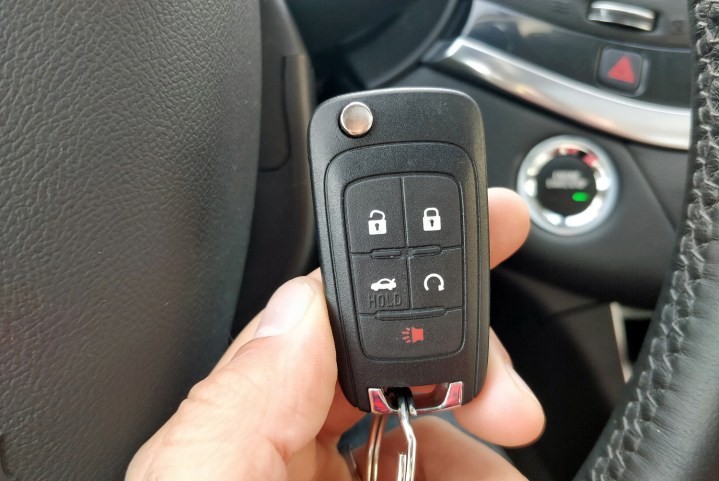
Chevrolet’s remote-start function is a real boon. It can save you time when escaping a hoard of hungry zombies by letting you start your car’s engine before you hop behind the wheel. On a more serious note, we often use it during the winter, because it allows us to warm up the engine without stepping out into the freezing cold to turn it on. Here’s how it works.
First, and most obviously, make sure your car is equipped with a remote-operated starter. The feature is available on a long list of cars made by Chevrolet and sister companies Buick, GMC, and Cadillac. The best way to tell whether you have it is to look at the key fob; the remote-start button is shaped like a curved arrow. If you don’t see it, your car is not equipped with it.
Found it? Good. Pressing it won’t do anything; pressing it twice won’t, either, and holding it down will get you nowhere. Start by pressing the lock-shaped button that locks the car once. Then, immediately press and hold the remote-start button (the arrow-shaped one) for at least four seconds, and your engine should roar to life. Chevrolet put together this sequence to ensure the car is locked when it starts, so someone walking their dog won’t be able to hop in and drive off, and to reduce the likelihood of the car starting itself because its owner pressed the remote-starter button by sitting on the key fob.
The parking lights turn on when the engine starts. The climate control turns on, too, and it returns to the last-used settings, so crank it up when you park at night if you want a hot cabin in the morning. You might also see the rear window defogger and the heated/ventilated seats come on. Note that you need to be relatively close to your car for the remote-start function to work; don’t expect the engine to start if you’re eight miles away from where you parked.
You’ve had your coffee, you’ve put on your coat, your engine is warm, and you’re ready to go. Remember, you locked your car before using the remote-start function, so you’ll need to unlock it before opening the door. And, this function turns on the engine, but it doesn’t turn on the ignition, so you can’t shift out of park until you push the start button on the dashboard. Once you’ve done that, simply press the brake pedal and move the gear lever out of park like you normally would.
There are a few points to keep in mind when using remote-start. First, the engine will only run for 15 minutes. You can repeat the aforementioned steps within 30 seconds of the first start to extend run time by 15 minutes, for a total of 30 minutes. You’re only allowed one extension. Second, the function is disabled if the hood isn’t closed, if the key fob is inside the car, or if the hazard lights are on. Third, make sure there’s enough fuel in the tank to power the engine for half an hour.
Let’s say you’ve changed your mind; you’re not leaving after all. Turning the engine off is as simple as pressing and holding the button with the curved arrow on it. If you can’t hear the car (if it’s in your driveway, for example), you’ll know it’s off when the parking lights turn off. You can also turn on the hazard lights, or use the ignition button on the dashboard.
Editors' Recommendations
- GM’s modular Ultium platform will be building block of its future electric cars
- Chevrolet’s in-car pizza-ordering app is the start of an ecommerce revolution



